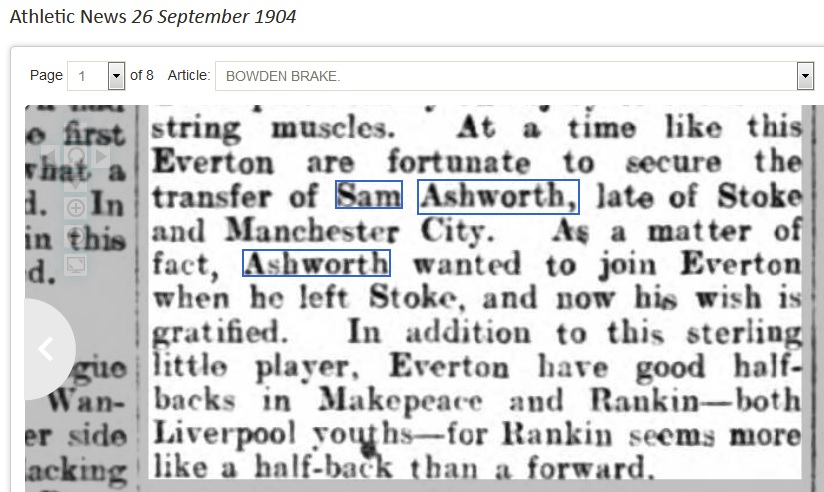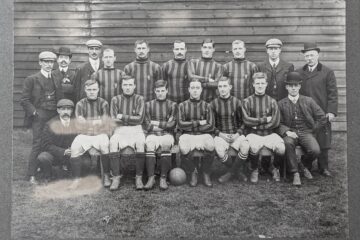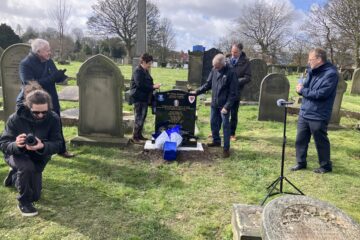
Samuel Bolton Ashworth was an amateur left-half of the early 1900s. Born 11 March 1877 in Fenton, Stoke-on-Trent, the son of a Mr. Thomas Ashworth who served as manager of Glebe Colliery, and Betsy Bolton; he was one of 10 children and played youth football with a succession of local sides in the Staffordshire leagues, before joining Football League founder members Stoke City for the 1901/02 season. In two seasons at Stoke, Sam Ashworth made 39 league and cup appearances, filling each of the half-back roles, but never scoring a goal – he never troubled the scorers once in his entire league and cup career.
After losing his position in the Stoke City side during his second season, Everton made enquiries about signing the neat, diminutive Ashworth to bolster their own options at half-back. For whatever reason and, despite Ashworth himself publicly stating his preference for a move to Goodison Park, Manchester City stepped in and he appeared for them – still on amateur terms – 22 times in league and cup during the 1903/04 season.

This would turn out to be City’s only season at the Hyde Road ground and a highly successful one at that. Ashworth would form a fine half-back pairing in the 18 appearances he made alongside star right-half, the Scot Tom Hynds, as City finished as runners up in the First Division and won the 1904 F.A. Cup. A 1-0 victory for City over Bolton Wanderers at the Crystal Palace, was notable for being the first all-Lancashire Cup Final and City’s first major trophy. Sam Ashworth appeared in the final in place of injured club stalwart Billy Holmes, in what would be his last appearance in a City shirt.
A brief spell in the Southern League with Reading would follow, before Everton came calling again. This time The Toffees got their man. The Athletic News reported on 26 September 1904 that ‘Everton are fortunate to secure the transfer of Sam Ashworth, late of Stoke and Manchester City. As a matter of fact, Ashworth wanted to join Everton when he left Stoke, and now his wish is granted’. The newspaper describes Ashworth as a ‘a sterling little player’.

A glance at Everton’s results and line-ups for the 1904/05 season reveals that club captain Tom Booth retired with what proved to be a serious injury early in the second half of the 1-0 victory over Preston North End at Goodison Park on 24 September 1904. Booth had begun the season at centre-half but, after the opening two fixtures, had missed the next three games. Youngster Tom Chadwick had played in Booth’s place and Everton had lost two of the three matches in his absence. Booth’s return appearance had, perhaps, been rushed and an existing injury aggravated. The name of Samuel Ashworth must have come to mind, his signature having been high on Everton’s agenda a little over a year previously. Ashworth was tracked down and, it would appear, brought in to plug the gap Booth’s absence would leave.
Sam Ashworth made his Everton debut away at Middlesbrough’s Ayresome Park in a 0-1 defeat on Saturday 1 October 1904. The Everton team that day was W.Scott, W.Balmer (captain in Tom Booth’s absence), J.Crelley, S.Ashworth, J.Taylor, H.Makepeace, B.Rankin, T.McDermott, A.Young, J.Settle, H.Hardman. With defeat, Everton dropped from fourth to ninth place in the First Division. A 2-1 win at home to Wolverhampton Wanderers on 8 October 1904 would bring Ashworth’s Goodison debut and first win as an Everton player. He missed the following game, another 2-1 win, at Bury but was back in the side for a 3-2 victory at Goodison over Aston Villa on 22 October 1904.
A visit to Lancashire neighbours Blackburn Rovers would see Everton stumble to another 0-1 away defeat, but that result was soon banished to the distant past by a firecracker of a 5-1 Goodison dismissal of Nottingham Forest on Bonfire Night, with goal-poacher supreme Alex ‘Sandy’ Young pilfering four of Everton’s five goals. A week later, on 12 November 1904, Everton and Ashworth would partake in an incredible match, the final score of which was Sheffield Wednesday 5 Everton 5. In attempting unsuccessfully to prevent the scoring of a third consolation goal for Wednesday in the 68th minute, the great Everton goalkeeper Billy Scott was left injured and unable to continue. Brummie inside-left Walter Abbott would take Scott’s place between the sticks but prove unable to keep a resurgent Wednesday at bay, conceding twice, including a last-minute equaliser, as Everton contrived to throw away what had been a second 5-1 lead in a week. In such moments league titles can be won or lost.
With goalkeeper Scott injured, the Everton board again thumbed through their contacts and opted to engage the services of another amateur. Leigh ‘Dick’ Roose was a superstar in his day, long before the cult of the celebrity footballer, and it was he who the directors summoned to fill the void between the Toffees’ goalposts. Roose, with fellow amateur Ashworth in front of him at left-half, made his Everton debut at Goodison Park on 19 November 1904, in a 0-1 defeat versus Sunderland. A first clean sheet for Roose would follow the following week as Everton played host to a 0-0 draw with Derby County, who included in their number the esteemed England international Steve Bloomer, he of the infamous ‘School of Science’ quote which Evertonians have held dear ever since.
Ashworth would miss the next three fixtures, the first of which, ironically, saw Everton send his hometown club Stoke City packing with a 4-1 defeat for their trouble. Small Heath were beaten 2-1 away, before the Christmas Eve fixture at Goodison against another of Ashworth’s previous clubs, Manchester City, served up another interesting aside. The match would finish 0-0 but was notable for the fact that new goalkeeper Roose never made it to the ground, due to thick fog terminally impeding his journey. With Billy Scott either in the stands or elsewhere and still recovering from injury, full-back Jack Crelley started the match in goal for 10-man Everton. Scott was summoned to ready himself and entered the fray after 12 minutes. What a fine Christmas farce for the spectators of both sides to enjoy!
Everton visited Molineux on Boxing Day 1904 with Sam Ashworth back in the side and goalkeeper Roose on time and in goal and returned to Merseyside with two points after a comprehensive 3-0 win in the Black Country. Missing from a 2-1 win at Derby County on 27 December 1904, perhaps a touch of early squad rotation in action, Ashworth returned to the half-back line on New Years’ Eve to help Everton dispatch Notts County 5-1 at Goodison, a rousing end to 1904 for Evertonians everywhere. Their side now sat in second place in the First Division table. A week later however, skipper Tom Booth would return after three months on the side lines for a 0-1 defeat at Sheffield United on 7 January 1905 and a 2-1 home win versus Newcastle United a week later.
Sam Ashworth would make his 11th and final appearance for Everton on 21 January 1905 at Deepdale, as Everton held Preston North End to a 1-1 draw. Ashworth would depart the first-team fray with Everton firmly in second place in the league, a position they would ultimately finish that season in, just one point adrift of Champions Newcastle United. The line-up for Ashworth’s final appearance was as follows; L.Roose, W.Balmer (capt.), R.Balmer, S.Ashworth, J.Taylor, W.Abbott, J.Sharp, B.Rankin, T.McDermott, J.Settle, H.Hardman.
In his 11 appearances, Ashworth played with some true Everton greats; from goalkeeper Scott, full-backs the Balmer brothers, stand-in centre-half Jack Taylor and half-back partner Harry Makepeace, to wingers Jack Sharp, who would serve Everton as player and director for many years and, like Makepeace, appear for Lancashire and England at cricket, and Harold Hardman, who would go on to serve Manchester United with distinction as director and chairman, and two of the club’s greatest pre-War strikers in Sandy Young and Jimmy Settle. Despite his limited contribution in terms of appearances made, Ashworth clearly made a positive difference wherever he went, as demonstrated during his season with Manchester City. Everton would win the F.A. Cup for the first time in 1906, perhaps a little of Ashworth’s Midas touch still lingered around the club.
In terms of an otherwise low-key Everton playing career, it was in the spring of 1905, some weeks after his final appearance in an Everton shirt that an interesting footnote would unfurl, as a non-footballing talent of Samuel Ashworth’s came to the fore. The reason Ashworth would remain an amateur throughout his nomadic 20-year football career was that he had a successful architectural firm to tend to at the same time. The Goodison Park board clearly knew about this, or at any rate Ashworth must have brought it to their attention, for in an entry to the Everton Ledgers on 7 April 1905, club directors discussed engaging their (otherwise unengaged bar the occasional run-out for the Everton Stiffs) left-half, Samuel Ashworth and charging him with the task of submitting sketches for a new office block and section of wall to enclose part of the Goodison Park perimeter at the St. Luke’s Church corner of the ground.
To quote directly from the Ledger for 1904/05: ‘Meeting of Everton F.C. Directors held at Goodison Park, 7 April 1905. Present: G. Mahon Esq. (Chair) Messrs Bainbridge, Baxter, Davies, Kirkwood, Wade, Whitford & Wright… The meeting having been convened for the purpose of discussing the plans of the proposed new offices & the St. Luke’s Rd. boundary wall it was resolved that… the office be removed from the present site to another to be selected… That a stand be erected on the site of the present office connecting the stands on the north and south sides thereof & that the details of the stand be left with the Ground Committee to bring up before the Board for approval, S. B. Ashworth to at once prepare such plan… That the necessary addition to the stand at the north end of Goodison Road occasioned by the building of St. Luke’s Rd. boundary wall hereinafter mentioned be shown in such plan… That an office be erected fronting to & at the South West (Goodison Rd.) end of the ground. S. B. Ashworth to submit a sketch to the Board.’
A meeting three weeks later at Goodison Park on 25 April 1905 requested available club directors to meet onsite the following morning at 11am to open the tenders for building of the St. Luke’s wall. Several high-profile directors were absent as the club were on an overseas tour at the time, but those available were ‘empowered to act as a full board in all matters’ pertaining to acceptance of whichever was deemed the most agreeable tender. Unfortunately, no record of any decision is recorded.
Several weeks thereafter at a board meeting on 5 June 1905, the Club Secretary ‘reported his interview with Ashworth re his charges for work on the ground… S. B. Ashworth would require 5% on contract price; 2½ from Contractor on quantities & would leave it to the Board to assess a value on his plan of proposed office… it was resolved that S. B. Ashworth be paid 5% as stated less payments made to him on a/c… together with £5.5.0 for his sketches of proposed office.’
In July a decision was reached in regard to Sam Ashworth’s services as an Everton footballer. At a board meeting held at the Bradford Hotel on 20 July 1905, ‘It was resolved that the Secretary be instructed to intimate to S. B. Ashworth… that we regret that we are unable to avail ourselves of his services next season.’
It was not until a meeting at Goodison Park on 29 August 1905 that the Club Secretary presented Sam Ashworth’s accounts to the Ground Committee for examination. In a follow-up meeting a week later, on 4 September 1905, directors Davies and Kelly, along with the Club Secretary were somewhat ominously ‘deputed to deal with S. B. Ashworth and make the best arrangement to close the matter.’ The matter appears to have been closed a fortnight later, where meeting notes from 19 September 1905 state that, regarding the ‘Retaining Wall… The payment of £20 to S. B. Ashworth in settlement of his claim was confirmed’.
The final reference in the Everton Ledgers pertaining to Samuel Ashworth appears on 31 October 1905, when ‘The Secretary reported that he had transferred S. B. Ashworth to Burslem Port Vale.’ Sam Ashworth the footballer had finally moved on, some 10 months after his final playing appearance, but following several months engagement with the club on some level in an architectural and business sense.
It is unclear as to whether any work ever took place at Goodison to Ashworth’s specifications. Indeed, it appears more likely from the documentation available that his efforts were met with ‘thanks, but no thanks’ from the Everton directors, who were then obliged to reach a settlement with Ashworth as regards hours he had perhaps put in at his drawing board back in Stoke.
Ashworth’s career in English League football wound down with only a further half-dozen appearances at Burslem Port Vale after his departure from Everton, but he would continue to play local football for a succession of clubs. For a man who made only 78 appearances at the level of the Football Association first and second tiers over a five-year period in his mid-20s, Ashworth could claim to have seen great success. He was part of two First Division runners-up teams with Manchester City and Everton and an F.A. Cup winner with City.
Like many footballers of his generation, Ashworth also saw active service in the First World War. He joined the Royal Garrison Artillery, in 1915, by now in his late-30s. By coincidence this was also the regiment of a fellow former Evertonian, striker Herbert Ernest ‘Bert’ Banks, who made two first-team appearances in 1896/97, having been bought out of the army by the Toffeemen. Banks would go on to score reasonably prolifically elsewhere and win a solitary England cap against Ireland in 1901, while playing for Millwall. Ashworth served in France and Belgium and was mentioned in despatches in the 11 December 1915 edition of the London Gazette which detailed his appointment as Second Lieutenant on 8 November 1915.

It was at home in Stoke where Ashworth would see out the remaining years of his life, contributing significantly to several high-profile municipal buildings in the city, before he passed away, aged just 48, on 30 December 1925. An obituary in the Staffordshire Advertiser remembers Samuel Ashworth as a noted architect, amateur footballer and director of Stoke City following the end of his playing career. He had served from 1903-1911 as architect to Fenton Educational Committee, assuming the same role at the Stoke-on-Trent Educational Committee upon the federation of the Potteries towns in 1911. This was a position he would occupy until his sudden and unexpected death, following a short illness.
Samuel Bolton Ashworth was buried at Fenton Cemetery, following a service at Fenton Parish Church, on 2 January 1926.

With Bramley-Moore on the horizon, literally and figuratively, it would be fascinating to find out whether any of the present Everton first-team squad had any interest in contributing to an aspect of the design work which will make our new home a reality.
Jamie Yates, 1 October 2019 (115 years to the day since Samuel Ashworth’s Everton debut!)
CREDITS:
Steve Johnson’s brilliant www.evertonresults.com
The Everton Ledgers as accessible via www.evertoncollection.org.uk
Manchester City: Player by Player; Matthews, Tony; Amberley Publishing (1 August 2013)
www.britishnewspaperarchive.org.uk www.footballandthefirstworldwar.org/samuel-ashworth-service-record




